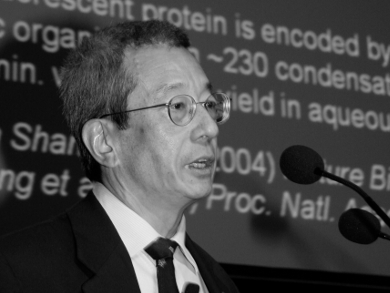Professor Roger Yonchien Tsien, University of California, San Diego, USA, passed away on August 24, 2016.
Professor Tsien received the Nobel Prize in Chemistry in 2008 together with Osamu Shimomura and Martin Chalfie for the discovery and development of the green fluorescent protein (GFP). GFP is used to track where and when a gene is expressed in a cell or in an organism. This can be done by fusing the respective gene with the gene for GFP and detecting the emitted light. Tsien showed that GFP could be engineered through amino acid substitutions to emit light in different colors [1].
Roger Y. Tsien was born in New York, USA. He studied chemistry and physics at Harvard University, Cambridge, MA, USA, and received his Ph.D. in physiology under the supervision of Jeremy Sanders from the University of Cambridge, UK, in 1977. Tsien remained at Cambridge for postdoctoral research from 1977 to 1981. He joined the University of California, Berkeley, USA, in 1982. In 1989, Professor Tsien moved to the University of California, San Diego, USA, where he worked as Professor of Pharmacology, Professor of Chemistry and Biochemistry, and investigator for the Howard Hughes Medical Institute.
In addition to the Nobel Prize, Professor Tsien received the American Chemical Society (ACS) Award for Creative Invention in 2002, the Christian B. Anfinsen Award from the Protein Society in 2002, and the Wolf Prize in Medicine from the Wolf Foundation in 2004, among many other honors. Professor Tsien gave a lecture at the launch event of ChemistryViews.org in Paris, France, in 2010.
Reference
- [1] Constructing and Exploiting the Fluorescent Protein Paintbox (Nobel Lecture) (free to read until December 31, 2016),
R. Y. Tsien,
Angew. Chem. Int. Ed. 2009, 48, 5612–5626.
DOI: 10.1002/anie.200901916
Other Selected Publications
- A Genetically Encoded Tag for Correlated Light and Electron Microscopy of Intact Cells, Tissues, and Organisms,
J. Richard McIntosh, Xiaokun Shu, Varda Lev-Ram, Thomas J. Deerinck, Yingchuan Qi, Ericka B. Ramko, Michael W. Davidson, Yishi Jin, Mark H. Ellisman, Roger Y. Tsien,
PLoS Biology 2011, 9, e1001041.
DOI: 10.1371/journal.pbio.1001041 - Surgery with molecular fluorescence imaging using activatable cell-penetrating peptides decreases residual cancer and improves survival,
Q. T. Nguyen, E. S. Olson, T. A. Aguilera, T. Jiang, M. Scadeng, L. G. Ellies, R. Y. Tsien,
Proc. Natl. Acad. Sci. USA 2010, 107, 4317–4322.
DOI: 10.1073/pnas.0910261107 - Activatable cell penetrating peptides linked to nanoparticles as dual probes for in vivo fluorescence and MR imaging of proteases,
E. S. Olson, T. Jiang, T. A. Aguilera, Q. T. Nguyen, L. G. Ellies, M. Scadeng, R. Y. Tsien,
Proc. Natl. Acad. Sci. USA 2010, 107, 4311–4316.
DOI: 10.1073/pnas.0910283107 - Constructing and Exploiting the Fluorescent Protein Paintbox (Nobel Lecture) (free to read until December 31, 2016),
R. Y. Tsien,
Angew. Chem. Int. Ed. 2009, 48, 5612–5626.
DOI: 10.1002/anie.200901916 - Characterization of Engineered Channelrhodopsin Variants with Improved Properties and Kinetics,
John Y. Lin, Michael Z. Lin, Paul Steinbach, Roger Y. Tsien,
Biophys. J. 2009, 96, 1803–1814.
DOI: 10.1016/j.bpj.2008.11.034 - Mammalian Expression of Infrared Fluorescent Proteins Engineered from a Bacterial Phytochrome,
X. Shu, A. Royant, M. Z. Lin, T. A. Aguilera, V. Lev-Ram, P. A. Steinbach, R. Y. Tsien,
Science 2009, 324, 804–807.
DOI: 10.1126/science.1168683 - Improving the photostability of bright monomeric orange and red fluorescent proteins,
Nathan C. Shaner, Michael Z. Lin, Michael R. McKeown, Paul A. Steinbach, Kristin L. Hazelwood, Michael W. Davidson, Roger Y. Tsien,
Nat. Methods 2008, 5, 545–551.
DOI: 10.1038/nmeth.1209 - Novel Chromophores and Buried Charges Control Color in mFruits,
Xiaokun Shu, Nathan C. Shaner, Corinne A. Yarbrough, Roger Y. Tsien, S. James Remington,
Biochemistry 2006, 45, 9639–9647.
DOI: 10.1021/bi060773l
Also of Interest
- Frontiers of Chemistry Pictures,
ChemViews Mag. 2010.
ChemPubSoc Europe and Wiley-VCH celebrated in Paris at the Frontiers of Chemistry Symposium



